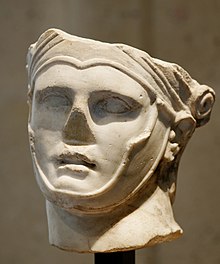Our website is made possible by displaying online advertisements to our visitors.
Please consider supporting us by disabling your ad blocker.
Seleucus I Nicator
| Seleucus I Nicator | |
|---|---|
| Basileus[a] | |
 Bust of Seleucus I Nicator, Roman artwork of the Imperial era made in a Syrian workshop after a Hellenistic model. | |
| Basileus of the Seleucid Empire | |
| Reign | 305[1] – September 281 BC |
| Predecessor | Alexander IV |
| Successor | Antiochus I Soter (co-ruler from c. 292 BC) |
| Born | c. 358 BC Europus, Macedon (modern-day Evropos, Greece) |
| Died | September 281 BC (aged c. 77) Lysimachia, Thrace (modern-day Kavakköy, Çanakkale, Turkey)[2][3] |
| Spouse | |
| Issue | Antiochus I Soter Achaeus Phila |
| Dynasty | Seleucid |
| Father | Antiochus |
| Mother | Laodice |
Seleucus I Nicator (/sɪˈluːkəs/;[4] Greek: Σέλευκος Νικάτωρ, Séleukos Nikátōr,[b] "Seleucus the Victorious"; c. 358 BC – 281 BC) was a Macedonian Greek general, officer and successor of Alexander the Great who went on to found the eponymous Seleucid Empire, led by the Seleucid dynasty. Initially a secondary player in the power struggles following Alexander's death, Seleucus rose to become the total ruler of Asia Minor, Syria, Mesopotamia, and the Iranian plateau, assuming the title of basileus (king). The Seleucid Empire was one of the major powers of the Hellenistic world, until it was overcome by the Roman Republic and Parthian Empire in the late second and early first centuries BC.
While serving under Alexander, Seleucus was commander of the Hypaspistai, an elite Macedonian infantry unit. After the death of Alexander in June 323 BC, Seleucus initially supported Perdiccas, the regent of Alexander's empire, and was appointed Commander of the Companions and chiliarch at the Partition of Babylon in 323 BC. However, after the outbreak of the Wars of the Diadochi in 322, Perdiccas' military failures against Ptolemy in Egypt led to the mutiny of his troops in Pelusium. Perdiccas was betrayed and assassinated in a conspiracy by Seleucus, Peithon and Antigenes in Pelusium sometime in either 321 or 320 BC. At the Partition of Triparadisus in 321 BC, Seleucus was appointed Satrap of Babylon under the new regent Antipater. But almost immediately, the wars between the Diadochi resumed and one of the most powerful of the Diadochi, Antigonus, forced Seleucus to flee Babylon. Seleucus was only able to return to Babylon in 312 BC with the support of Ptolemy. From 312 BC, Seleucus ruthlessly expanded his dominions and eventually conquered the Persian and Median lands. Seleucus ruled not only Babylonia, but the entire eastern part of Alexander's empire.
Seleucus further made claim to the former satrapies in Gandhara and in northwest India. However these ambitions were contested by Chandragupta Maurya, resulting in the Seleucid–Mauryan War (305–303 BC). The conflict was ultimately resolved by a treaty resulting in the Maurya Empire annexing the eastern satrapies. Additionally, a marriage alliance was formed, with Chandragupta marrying a daughter of Seleucus, according to Strabo and Appian.[5] Furthermore, the Seleucid Empire received a considerable military force of 500 war elephants with mahouts, which would play a decisive role against Antigonus at the Battle of Ipsus in 301 BC. In 281 BC, he also defeated Lysimachus at the Battle of Corupedium, adding Asia Minor to his empire.
Seleucus' victories against Antigonus and Lysimachus left the Seleucid dynasty virtually unopposed amongst the Diadochi. However, Seleucus also hoped to take control of Lysimachus' European territories, primarily Thrace and Macedon itself. But upon arriving in Thrace in 281 BC, Seleucus was assassinated by Ptolemy Ceraunus,[2] who had taken refuge at the Seleucid court with his sister Lysandra. The assassination of Seleucus destroyed Seleucid prospects in Thrace and Macedon, and paved the way for Ptolemy Ceraunus to absorb much of Lysimachus' former power in Macedon. Seleucus was succeeded by his son Antiochus I as ruler of the Seleucid Empire. Seleucus founded a number of new cities during his reign, including Antioch (300 BC), Edessa and Seleucia on the Tigris (c. 305 BC), a foundation that eventually depopulated Babylon.
Cite error: There are <ref group=lower-alpha> tags or {{efn}} templates on this page, but the references will not show without a {{reflist|group=lower-alpha}} template or {{notelist}} template (see the help page).
- ^ Boiy "The Reigns of the Seleucid Kings According the Babylonian King List." Journal of Near Eastern Studies 70(1) (2011): 1–12.
- ^ a b Cite error: The named reference
EB1911was invoked but never defined (see the help page). - ^ "Seleucus I Nicator". Livius.
- ^ Seleucus | Collins English dictionary
- ^ Appian, p. 55.
Previous Page Next Page


